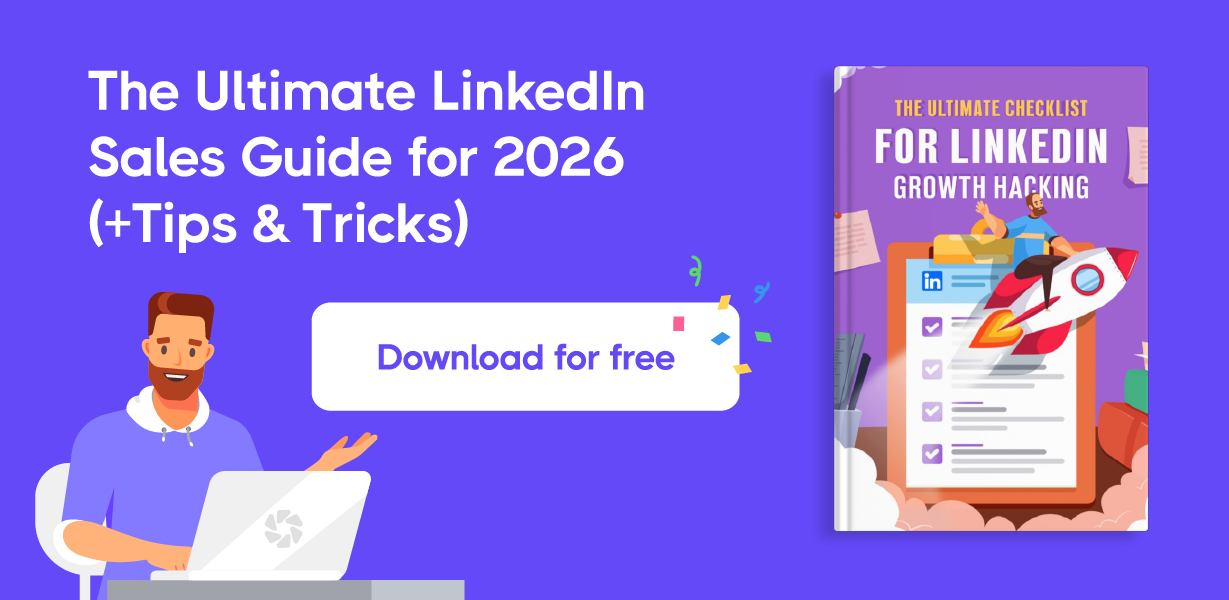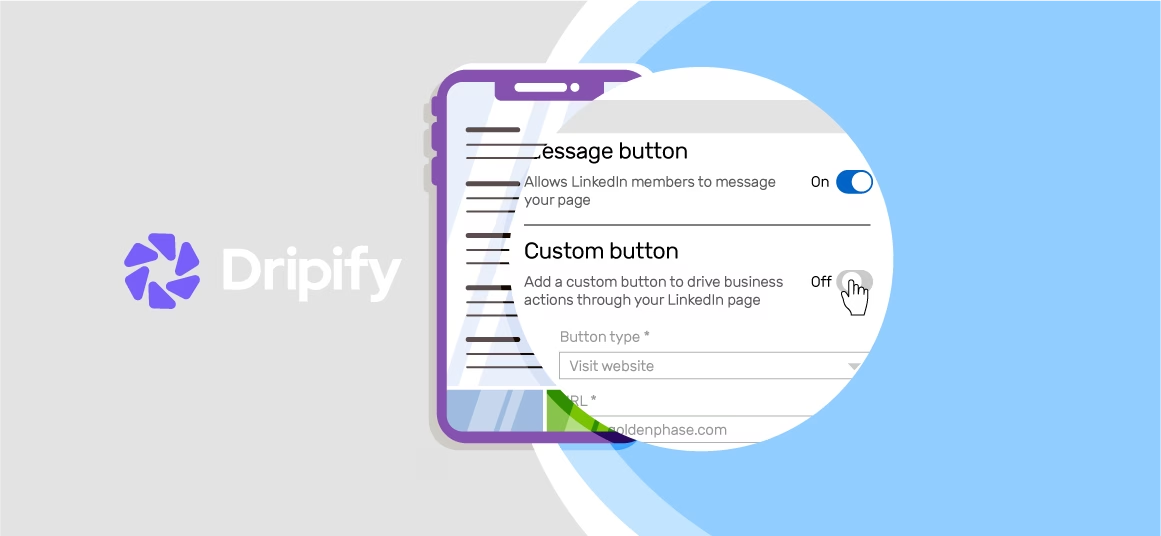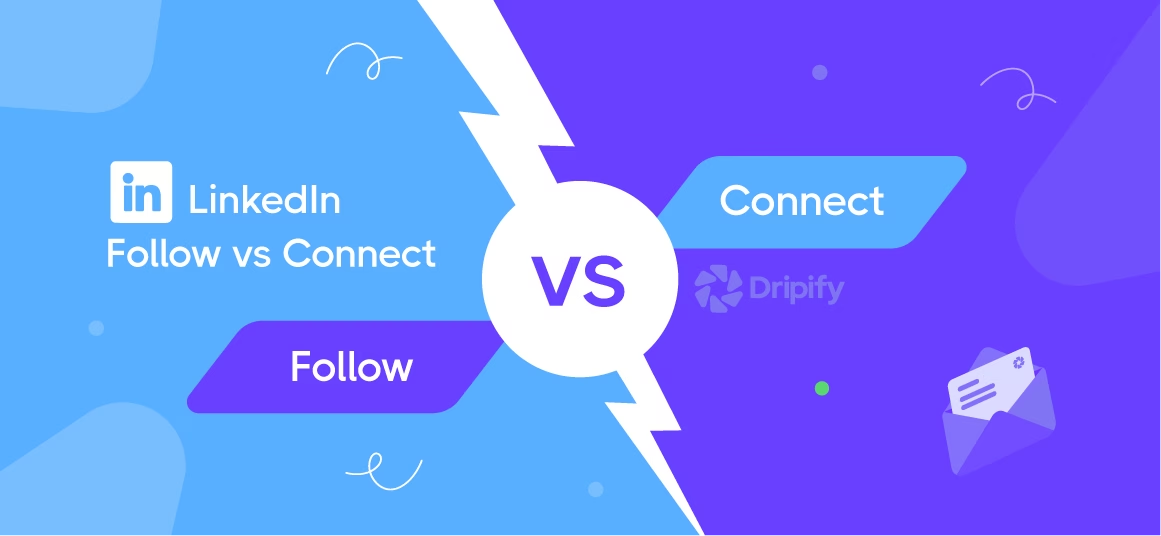| Getting your Trinity Audio player ready… |
LinkedIn follow vs connect, what’s the difference? This is a common question among LinkedIn users, especially those looking to expand their professional reach or build meaningful relationships. Knowing the difference between follow vs connect on LinkedIn can help you engage with the right people in the right way.
Are followers and connections the same on LinkedIn? The simple answer is, no. LinkedIn provides you with two primary ways to engage with other users: following and connecting. In other words, connect vs follow on LinkedIn are two distinct methods of networking.
- What Is Follow vs Connect on LinkedIn?
- What Is the Difference of LinkedIn Follow vs Connect?
- LinkedIn Followers vs Connections: Which Is Better?
- Do Connections Turn into Followers on LinkedIn?
- How to Get Followers on Linkedin vs Connections
- Growing Connections on LinkedIn
- Growing Followers on LinkedIn
- How Dripify Helps Automate Following and Connecting on LinkedIn
What Is Follow vs Connect on LinkedIn?
When visiting a LinkedIn user’s profile, you get two options to engage with them: Follow and Connect. When you click on the Connect button, LinkedIn sends a connection request notification to that user. It is now at the discretion of the user to accept or ignore your connection request.
If the person you sent an invite accepts your request, you become 1st-degree connections. It means both of you can now directly message each other, view each other’s posts, and engage more closely. Connections require mutual acceptance, making them ideal for building professional relationships.
When you click on the Follow button on a LinkedIn user’s profile, LinkedIn does not send them a notification to accept your request. Instead, you become their follower right away. This means you can now see their posts shared publicly on the platform.
However, the people you follow won’t see your publicly shared posts unless they follow you back. To put it another way, following is a one-way engagement that doesn’t require approval, making it perfect for keeping up with influencers, industry experts, or professionals who don’t accept connection requests from people they don’t know personally.
Also, keep in mind that while LinkedIn automatically turns your 1st-degree connections into followers, not all followers become connections. That is to say, following expands your network without requiring direct engagement.
What Is the Difference of LinkedIn Follow vs Connect?
Here’s a table summarizing the key differences between Follow vs. Connect on LinkedIn:
| Feature | Follow | Connect |
|---|---|---|
| Type of Engagement | One-way (you see their posts, but they don’t see yours unless they follow back) | Two-way (both parties can see and engage with each other’s content) |
| Messaging | You cannot message someone you follow unless they accept your connection request | You can message your 1st-degree connections directly |
| Visibility | You see their posts in your feed if they post publicly | Both parties automatically see each other’s posts in their feed |
| Approval Required? | No approval is needed. You can follow anyone with public posts | Requires the other person to accept your request |
| Relationship Depth | More passive. Useful for staying updated on industry leaders and influencers | More interactive. Ideal for networking, collaboration, and business relationships |
| Best for… | Expanding your knowledge, staying informed about key industry figures, and increasing content reach | Building meaningful professional relationships, lead generation, and business development |
| Follower/Connection Limit | Unlimited followers | Maximum of 30,000 connections |
| Can You Remove? | You can unfollow anytime without notifying the person | You can remove a connection, but they will no longer see your posts automatically |
| Profile Settings | You can set your profile to “Follow First” mode, encouraging more people to follow instead of sending connection requests | The default setting allows connections, but you can limit who can send requests |
From the table, you can see that LinkedIn connections vs followers serve different purposes. Connections foster deeper relationships, while followers expand your reach. If you want to engage with other professionals, it is good to build more connections. On the other hand, if your goal is to achieve more visibility, you should increase your followers.
Another key thing to remember is that LinkedIn’s algorithm favors engagement. With this in mind, choosing whether to connect or follow should align with your long-term professional goals.
Also, remember that with a basic LinkedIn profile, you can only send an average of 100 connection requests per week but there’s no limit on how many people you can follow each day. Better yet, following lets you show up in someone’s notifications without needing their approval.
That means if you’ve maxed out your weekly connection requests, following is a smart way to stay on their radar. Best of all, if their profile is open, you can send them a free InMail to start a conversation. But even if messaging isn’t an option, following still increases your visibility and keeps the door open for future engagement.
LinkedIn Followers vs Connections: Which Is Better?
Now that you know the core difference between connections vs followers on LinkedIn, you might wonder: Should I connect or follow people on LinkedIn?
Let’s have a look at how each of these can affect your networking, engagement, and visibility on the platform.
- If you want a strong, interactive professional network, consider creating more connections than followers;
- If your goal is to increase reach and authority, get more followers;
- If you’re an industry expert or content creator, a large follower base can increase your credibility;
- If you’re in sales or recruiting, direct connections will help you have deeper relationships and better lead nurturing;
- If you own a business, having many followers can increase your brand awareness and engagement.
Is it better to have followers or connections on LinkedIn? A combination of connections and followers often works best. This approach helps you leverage both options to build meaningful relationships while maximizing visibility.

Do Connections Turn into Followers on LinkedIn?
Yes, every 1st-degree connection automatically becomes a follower. This means you don’t need to separately follow people on LinkedIn connection to see their posts and updates. However, not all followers are connections.
If someone removes you as a connection, you lose that direct relationship but may remain a follower if they were already following you before becoming a connection. Then again, if you remove people on LinkedIn who don’t follow you, they will no longer see your posts unless they choose to follow you again.
LinkedIn allows users to unfollow their connections while remaining connected. This feature lets you control your feed and maintain professional ties.
How to Get Followers on Linkedin vs Connections
Below are some hands-on tips on how to expand your connections vs followers on LinkedIn.
Growing Connections on LinkedIn
- Instead of sending generic invites, include a brief message explaining why you want to connect. You can personalize your request by mentioning things like a post or an achievement from the recipient’s profile;
- Engage with other LinkedIn users through comments on relevant posts and participating in groups. This will give you more exposure and lead to new connections;
- One of the best ways to increase your connections is to post insightful content. Helpful and unique posts position you as an authority in your field. When industry professionals see valuable posts, they will want to connect with you;
- People use keywords to find and connect with other industry professionals on the platform. This means when you optimize your LinkedIn profile with relevant keywords, you’re more likely to appear in search results;
- LinkedIn events and webinars are a great way to meet new people from your niche or industry. It is a good idea to attend these sessions and engage with other participants. After the session, you can send them an invite to connect;
- As you might already know, LinkedIn suggests connections based on your email contact. You can use this as an opportunity to increase your connections.
Growing Followers on LinkedIn
- Enable the ‘Follow’ button on your LinkedIn profile and adjust your settings to prioritize follows over connection requests;
- Just as with getting more connections, publishing high-quality posts frequently can help increase your follower base. Just make sure to set the privacy of your posts to public;
- Follow other industry leaders and influencers and leave genuine reactions and comments on their posts. This may encourage them and their followers to follow you back;
- Do not hesitate to add a CTA at the end of your posts, subtly asking the readers to follow you for more informative and helpful posts or articles;
- Tag your posts and articles with relevant, industry-specific hashtags. Strategic use of hashtags will expand your content’s reach and increase your followers;
- Publishing long-form articles (LinkedIn pulse content) is an excellent method to establish authority in your field, which, in turn, can help expand your follower base.
How Dripify Helps Automate Following and Connecting on LinkedIn
Dripify is a next generation AI LinkedIn automation tool that lets you grow your connections and followers on complete autopilot. You can use it to automatically visit relevant profiles on your behalf and send personalized connection requests.
Dripify can even engage with other LinkedIn users using human-like algorithms. For example, you can set it to automatically like posts and even endorse skills. This engagement can improve your visibility and engagement metrics, ultimately helping you get the first 500 connections on LinkedIn as quickly as possible.
Moreover, the Dripify sales automation software provides you with rich features like using data-driven analytics to track connection and follower growth, A/B testing capability to optimize your outreach campaigns, creating personalized drip campaigns, and much more.
Conclusion
Now that you know the difference between followers vs connections on LinkedIn, you can use the tips and insights from this article to build a vast and more engaging network. If you’re looking for more engagement and direct communication, focus on growing your connections. But if you want to increase your reach and influence, you should grow your followers.
All things considered, a balanced approach is the best way to use LinkedIn to its optimum potential. Getting more connections and followers can help support your long-term goals. However, manually increasing your followers or connections takes time and effort. Dripify can help you with that. With the Dripify LinkedIn automation tool, you can follow people on LinkedIn, visit profiles, send hyper-personalized invitations, engage with industry professionals, and scale your networking activities, all in AI autopilot mode. Try Dripify for free!
Recommended For You

LinkedIn Call to Action for Lead Generation
LinkedIn has always been at the forefront of introducing new and exciting features to help businesses make the best use…
![Email Outreach Tracking [Tips, Tricks and Tools]](https://dripify.com/wp-content/uploads/2025/02/11-7-png.avif)
Email Outreach Tracking [Tips, Tricks and Tools]
Email outreach is one of the most effective and affordable marketing tools available to reach your target customers. As a…
![Create a Prospecting Plan [+8 Prospecting Methods]](https://dripify.com/wp-content/uploads/2025/02/11-png.avif)
Create a Prospecting Plan [+8 Prospecting Methods]
No matter your business, you need a steady flow of new prospects for a steady revenue stream. Prospecting is time-intensive…
Try out a smarter way to crush sales
Kickstart your sales outreach campaign today and see your first results in less than 48 hours, while enjoying your free trial
10 people or more? Get a personalized introduction to Dripify
